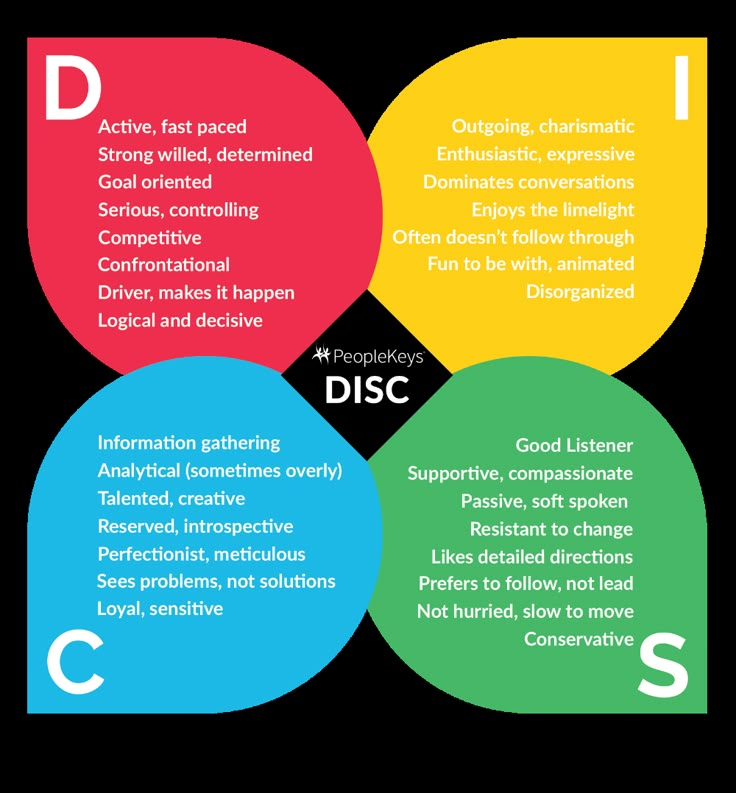Dominant personality type
How Can You Tell If Someone Has a Dominant Personality?
A dominant personality involves traits like proactivity, assertiveness, and often, extroversion. Agression and manipulation are also possible.
That assertive co-worker pushing you to your limits might be a team asset and goal-oriented, but a dominant personality could be challenging to handle.
Not all people with a dominant personality behave in the same way. You could find a self-assured friend who always seems to lead the way or a peer who doesn’t hesitate to use intimidation to get what they want.
In general, some of the traits associated with this power-oriented personality type can be challenging to navigate.
A dominant personality is a personality type that often leads themselves and others into action. It’s primarily defined by an overarching motivation for power and a sense of pride.
This doesn’t mean dominant personalities are always eager to obtain power or behave like tyrants. Instead, it may mean some of them can behave in ways that are persistently:
- confident
- assertive
- unrelenting
Dominance across many species is often associated with patterns of behaviors that involve intimidation, coercion, and aggression. But when it comes to humans, this isn’t always the case or if it is, it doesn’t always have a negative connotation.
In 1928, William Moulton Marston proposed a human behavioral model of emotions now known as DiSC, which categorized human behaviors into four quadrants:
- dominance
- inducement (influence)
- submission
- compliance
Under the DiSC model, dominant personality traits include:
- impatience
- manipulation
- egotism
- bluntness
- stubbornness
- determination
- aloofness
- perfectionism
- restlessness
But, according to Dr. Nereida Gonzalez-Berrios, a board certified psychiatrist out of Houston, being dominant isn’t solely about the negative, controlling behaviors. This would be one end of the possibility spectrum of dominant traits.
“A person with a dominant personality type is assertive, courageous, proactive, and self-reliant,” she says. “They are focused and goal-oriented as well.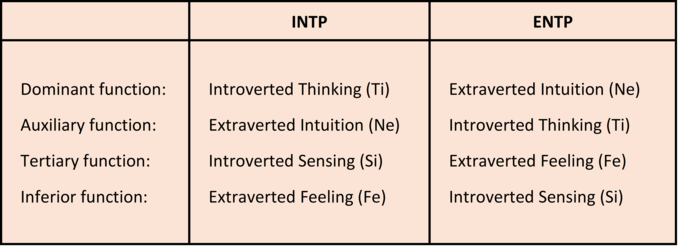 These individuals carry themselves in a manner that is socially impressive and emanates positive vibes to others.”
These individuals carry themselves in a manner that is socially impressive and emanates positive vibes to others.”
She adds that dominant personalities often have high self-esteem and confidence levels.
Other characteristics Gonzalez-Berrios says may come with a dominant personality include:
- dedication to hard work
- strong leadership abilities
- high positivity
- stoicism
- self-control
- confident body language
Dominant vs. influential personality
Under the DiSC model, dominant personality is associated with results or reaching a goal. It’s about “leading the way.”
Influential personalities can also be leaders, but under DiSC standards, they do so by working with those around them, cultivating relationships, and focusing on social recognition rather than achievements.
Gonzalez-Berrios explains dominant personalities are not usually strong with social skills.
Instead, as goal-oriented, driven individuals, they can be challenging to sway with compromise and may be rigid in their processes and thoughts.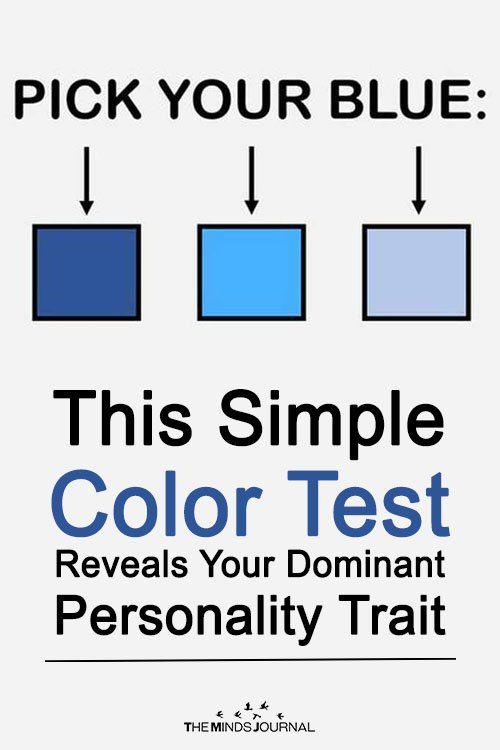
“As far as empathy and compassion are concerned, it is usually less than others,” she says. “They do not
like to follow but prefer to lead.”
Being dominant in relationships may come naturally to some people. Dominant personalities like the challenge of leading others, for example, or they feel empowered when they take charge.
A dominant personality in a relationship may want to make decisions for you, but they could also encourage and motivate you to action.
In some cases, dominant tendencies may lead someone to engage in abusive and toxic relationship behaviors.
But abusive behaviors in a relationship, which are always about power and control, can be signs of a mental health condition and not only a personality type.
A 2012 review into dominance behavior found dominant personality traits often overlapped with mania and narcissism.
Psychopathy has also been associated with dominance and power seeking, though a 2017 study found this framework of dominance was linked primarily to gaining social standing and not personal achievement.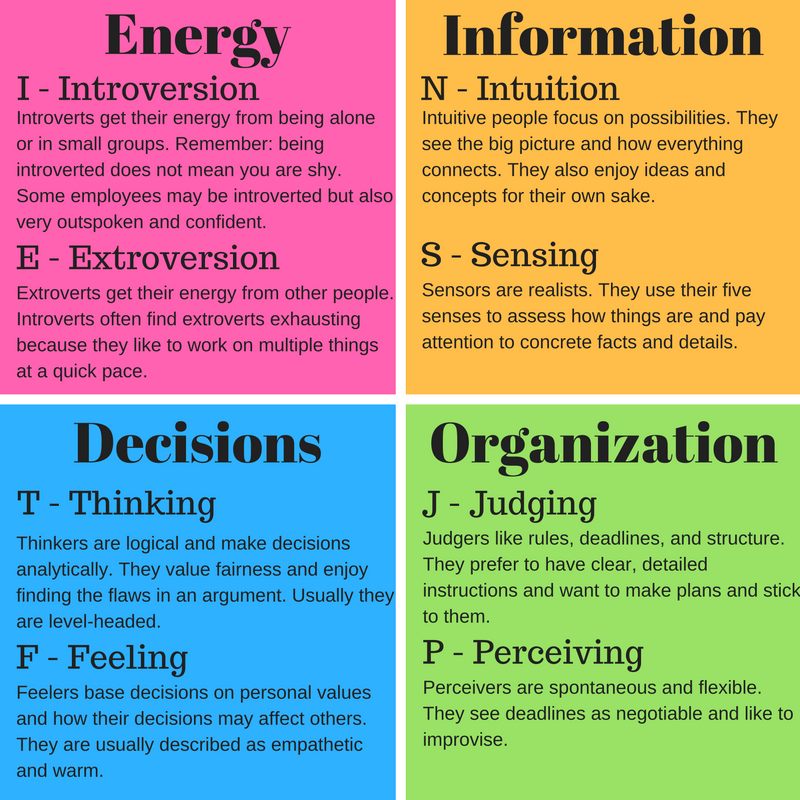
To deal with a dominant personality in your life, Gonzalez-Berrios recommends the following tips.
Changing your communication style
“You need to be commanding and clear about your needs with them,” says Gonzalez-Berrios. “They are not interested in finding out hidden stories.”
Gonzalez-Berrios suggests:
- avoiding small talk
- steering clear of nit-picking
- focus on facts and outcomes during a conversation
Accepting them for who they are
A dominant person’s behavior isn’t a reflection of how they feel about you. Most likely, they aren’t targeting you — they treat everyone, including themselves, this way.
They may not use sweet-talking or display a friendly attitude, says Gonzalez-Berrios. Instead, they may come through as bold, straightforward and to-the-point.
Most of the time, they expect the same from you.
Staying one step ahead
Gonzales-Berrios suggests keeping up on new skills and efficiency routines that may help you appeal to the problem-solving nature of a dominant personality type.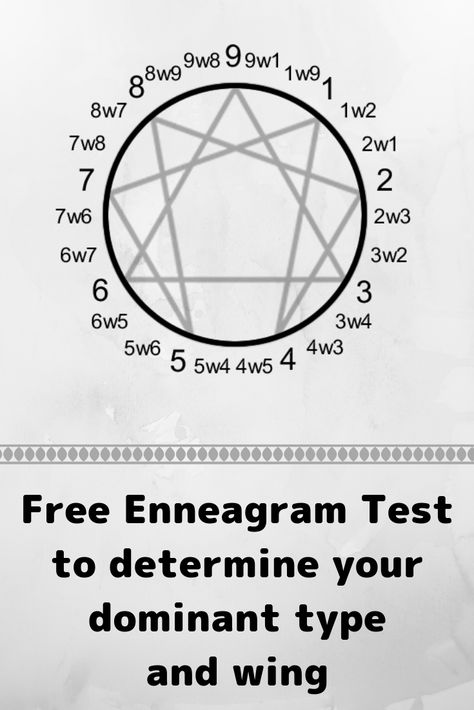
If you’re one step ahead, it can be difficult for them to feel the need to direct you.
Setting boundaries
Accepting dominant personality traits doesn’t mean you have to put up with inappropriate behaviors or with attitudes you don’t feel comfortable with.
Setting clear boundaries can be a way for you to protect your physical and mental well-being. It can also provide a standard and a way to say “no” without needing a list of reasons or excuses.
While a dominant personality is often associated with negative traits of aggression and manipulation, there are many positive traits to be recognized, as well. Dominant people can be strong leaders, dedicated, and goal-oriented.
If you’re finding it challenging to co-exist with a dominant personality, changing your communication style and setting clear boundaries can help.
How Can You Tell If Someone Has a Dominant Personality?
A dominant personality involves traits like proactivity, assertiveness, and often, extroversion. Agression and manipulation are also possible.
Agression and manipulation are also possible.
That assertive co-worker pushing you to your limits might be a team asset and goal-oriented, but a dominant personality could be challenging to handle.
Not all people with a dominant personality behave in the same way. You could find a self-assured friend who always seems to lead the way or a peer who doesn’t hesitate to use intimidation to get what they want.
In general, some of the traits associated with this power-oriented personality type can be challenging to navigate.
A dominant personality is a personality type that often leads themselves and others into action. It’s primarily defined by an overarching motivation for power and a sense of pride.
This doesn’t mean dominant personalities are always eager to obtain power or behave like tyrants. Instead, it may mean some of them can behave in ways that are persistently:
- confident
- assertive
- unrelenting
Dominance across many species is often associated with patterns of behaviors that involve intimidation, coercion, and aggression.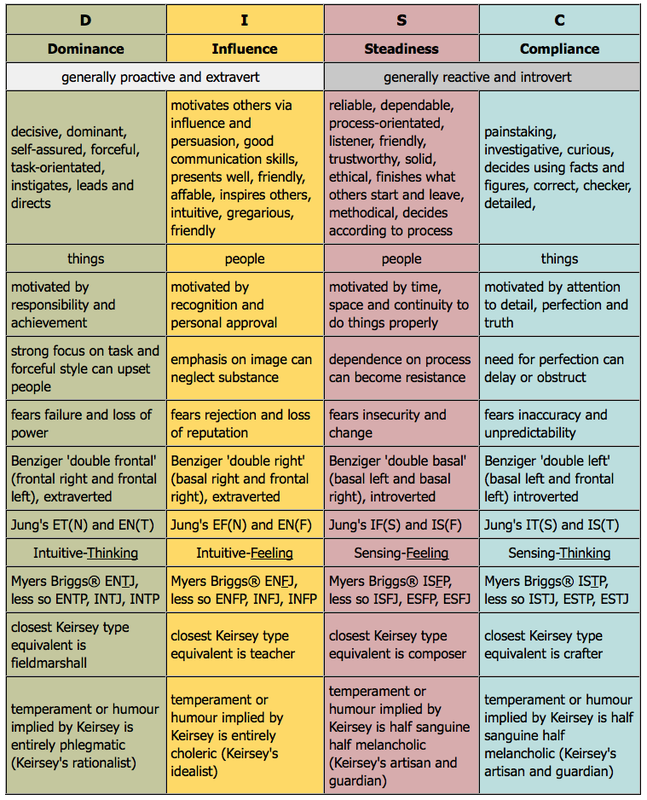 But when it comes to humans, this isn’t always the case or if it is, it doesn’t always have a negative connotation.
But when it comes to humans, this isn’t always the case or if it is, it doesn’t always have a negative connotation.
In 1928, William Moulton Marston proposed a human behavioral model of emotions now known as DiSC, which categorized human behaviors into four quadrants:
- dominance
- inducement (influence)
- submission
- compliance
Under the DiSC model, dominant personality traits include:
- impatience
- manipulation
- egotism
- bluntness
- stubbornness
- determination
- aloofness
- perfectionism
- restlessness
But, according to Dr. Nereida Gonzalez-Berrios, a board certified psychiatrist out of Houston, being dominant isn’t solely about the negative, controlling behaviors. This would be one end of the possibility spectrum of dominant traits.
“A person with a dominant personality type is assertive, courageous, proactive, and self-reliant,” she says. “They are focused and goal-oriented as well.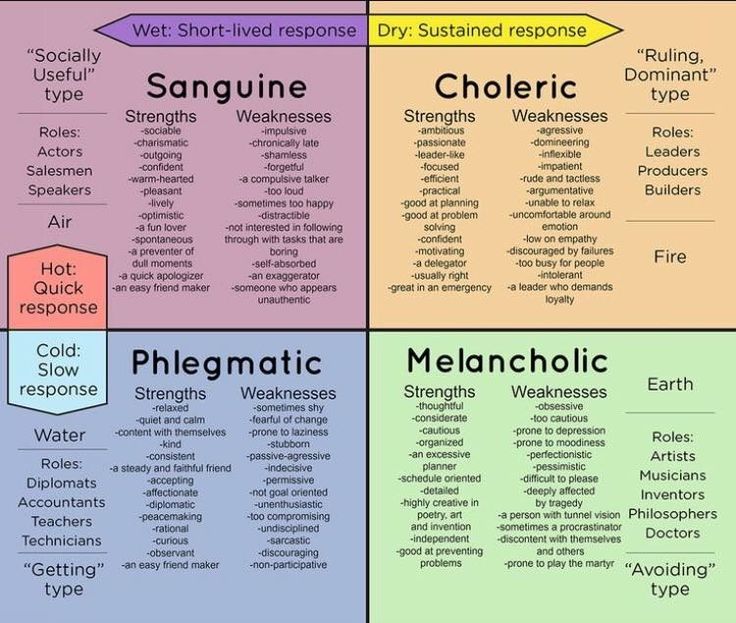 These individuals carry themselves in a manner that is socially impressive and emanates positive vibes to others.”
These individuals carry themselves in a manner that is socially impressive and emanates positive vibes to others.”
She adds that dominant personalities often have high self-esteem and confidence levels.
Other characteristics Gonzalez-Berrios says may come with a dominant personality include:
- dedication to hard work
- strong leadership abilities
- high positivity
- stoicism
- self-control
- confident body language
Dominant vs. influential personality
Under the DiSC model, dominant personality is associated with results or reaching a goal. It’s about “leading the way.”
Influential personalities can also be leaders, but under DiSC standards, they do so by working with those around them, cultivating relationships, and focusing on social recognition rather than achievements.
Gonzalez-Berrios explains dominant personalities are not usually strong with social skills.
Instead, as goal-oriented, driven individuals, they can be challenging to sway with compromise and may be rigid in their processes and thoughts.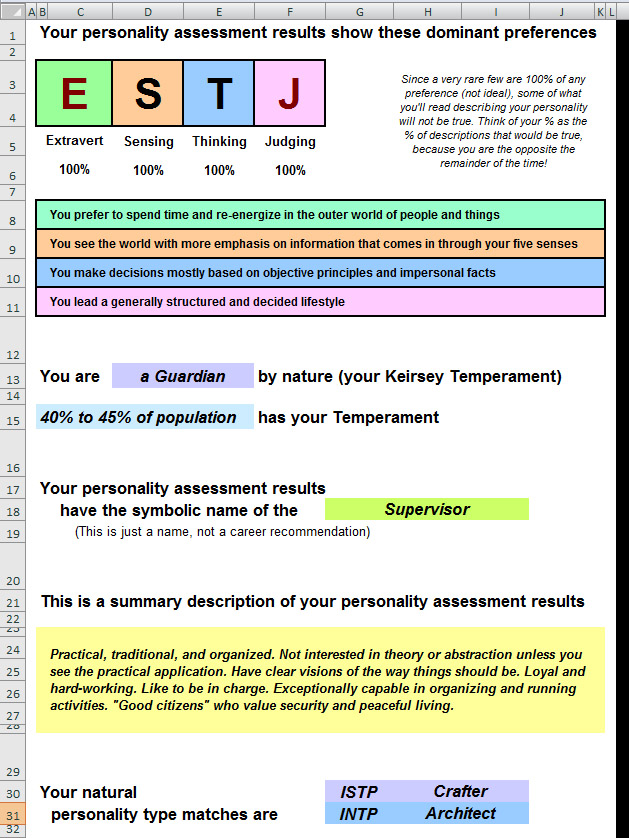
“As far as empathy and compassion are concerned, it is usually less than others,” she says. “They do not
like to follow but prefer to lead.”
Being dominant in relationships may come naturally to some people. Dominant personalities like the challenge of leading others, for example, or they feel empowered when they take charge.
A dominant personality in a relationship may want to make decisions for you, but they could also encourage and motivate you to action.
In some cases, dominant tendencies may lead someone to engage in abusive and toxic relationship behaviors.
But abusive behaviors in a relationship, which are always about power and control, can be signs of a mental health condition and not only a personality type.
A 2012 review into dominance behavior found dominant personality traits often overlapped with mania and narcissism.
Psychopathy has also been associated with dominance and power seeking, though a 2017 study found this framework of dominance was linked primarily to gaining social standing and not personal achievement.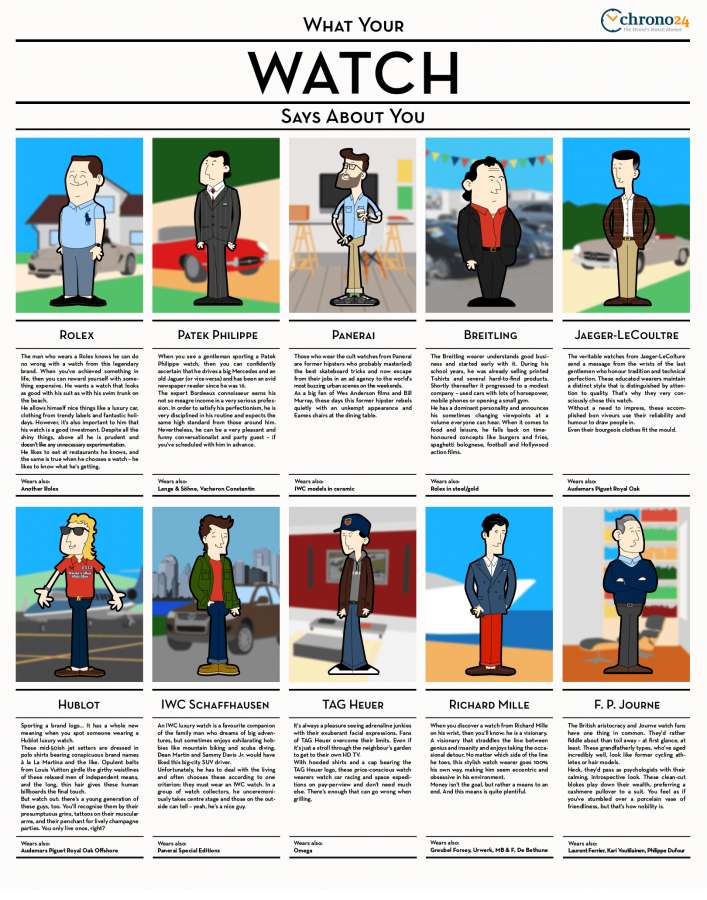
To deal with a dominant personality in your life, Gonzalez-Berrios recommends the following tips.
Changing your communication style
“You need to be commanding and clear about your needs with them,” says Gonzalez-Berrios. “They are not interested in finding out hidden stories.”
Gonzalez-Berrios suggests:
- avoiding small talk
- steering clear of nit-picking
- focus on facts and outcomes during a conversation
Accepting them for who they are
A dominant person’s behavior isn’t a reflection of how they feel about you. Most likely, they aren’t targeting you — they treat everyone, including themselves, this way.
They may not use sweet-talking or display a friendly attitude, says Gonzalez-Berrios. Instead, they may come through as bold, straightforward and to-the-point.
Most of the time, they expect the same from you.
Staying one step ahead
Gonzales-Berrios suggests keeping up on new skills and efficiency routines that may help you appeal to the problem-solving nature of a dominant personality type.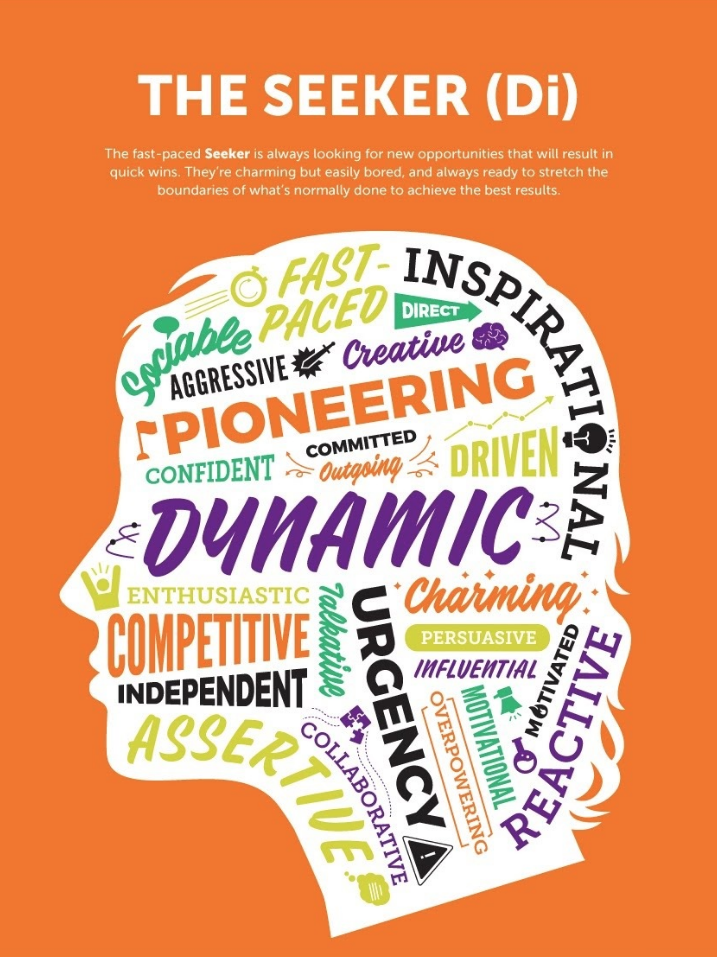
If you’re one step ahead, it can be difficult for them to feel the need to direct you.
Setting boundaries
Accepting dominant personality traits doesn’t mean you have to put up with inappropriate behaviors or with attitudes you don’t feel comfortable with.
Setting clear boundaries can be a way for you to protect your physical and mental well-being. It can also provide a standard and a way to say “no” without needing a list of reasons or excuses.
While a dominant personality is often associated with negative traits of aggression and manipulation, there are many positive traits to be recognized, as well. Dominant people can be strong leaders, dedicated, and goal-oriented.
If you’re finding it challenging to co-exist with a dominant personality, changing your communication style and setting clear boundaries can help.
DISC methodology in the work of HR specialists: what it is and how to use it
An HR specialist is always a bit of a psychologist.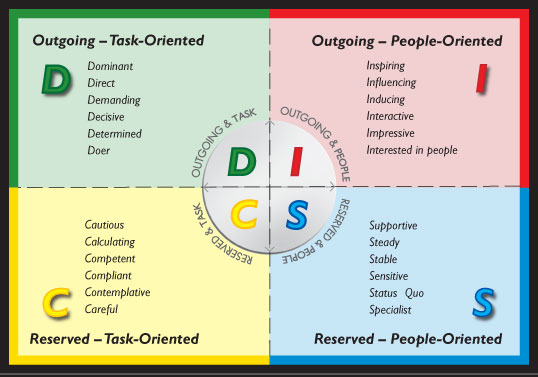 It is he who first meets the candidate, determines his skills, and in the future builds a successful team brick by brick. Today we will talk about the DISC technique, which already at the first interview after 10-15 minutes will help to recognize who is in front of you and what kind of work he is suitable for.
It is he who first meets the candidate, determines his skills, and in the future builds a successful team brick by brick. Today we will talk about the DISC technique, which already at the first interview after 10-15 minutes will help to recognize who is in front of you and what kind of work he is suitable for.
What is DISC?
DISC is a 4-step behavioral model that explores how people behave under specific circumstances. DISC does not assess a person's IQ or emotional intelligence, nor does it reveal a person's values, education, or experience. The system only helps to recognize the characteristics of a person's behavioral type and determine how suitable he is for working on specific tasks.
The DISC technique became known in the 1980s. American entrepreneur Bill J. Bonnstetter, based on the work of psychologists Carl Jung and William Marston, was the first to introduce the development of a computer program based on the DISC model.
The methodology in the work of HR specialists can be useful in recruiting, staff adaptation and team building training.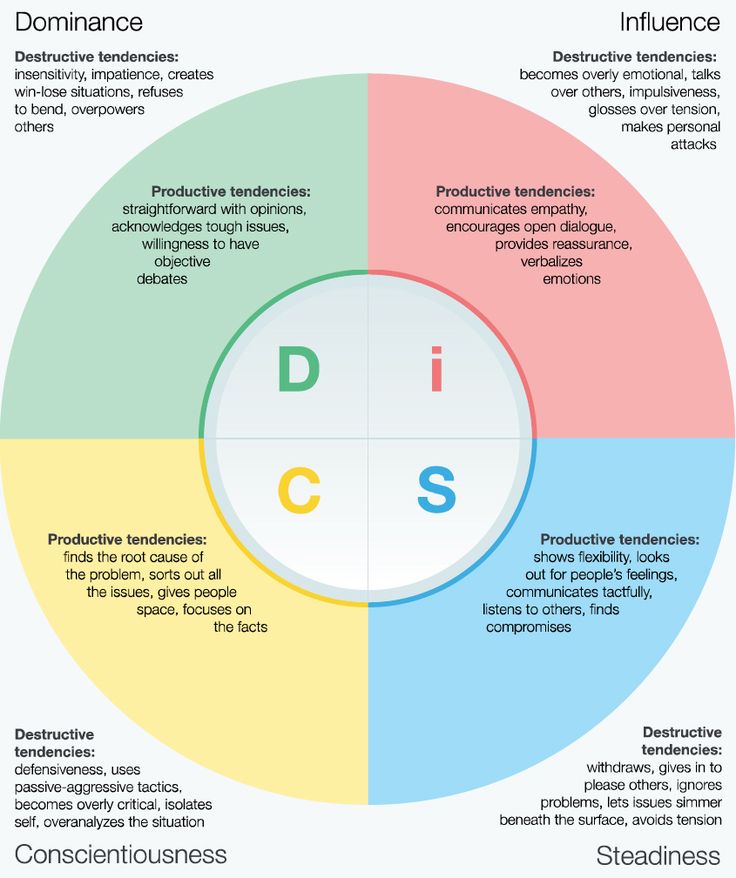 This means that already at the interview stage, HR using DISC is more likely to hire the right candidate for a certain type of task.
This means that already at the interview stage, HR using DISC is more likely to hire the right candidate for a certain type of task.
4 DISC Personality Types
Type D: Dominant Reds
People with a high D factor are clear leaders. They are straightforward, self-confident, make decisions quickly. They always strive to occupy leadership positions, because they love and, most importantly, know how to give out commands. They often do 101% to show their best and achieve their goals no matter what. This type of employee does not sit idle, which is noticeable even at the first interview.
Pros:
- not afraid to take on difficult tasks;
- like to compete;
- feel good in difficult conditions.
Cons:
- sharp and quick-tempered;
- they lack patience and sometimes diplomacy;
- prone to aggression.
How to recognize at the first interview. Such candidates may dominate the conversation and try to fill awkward gaps.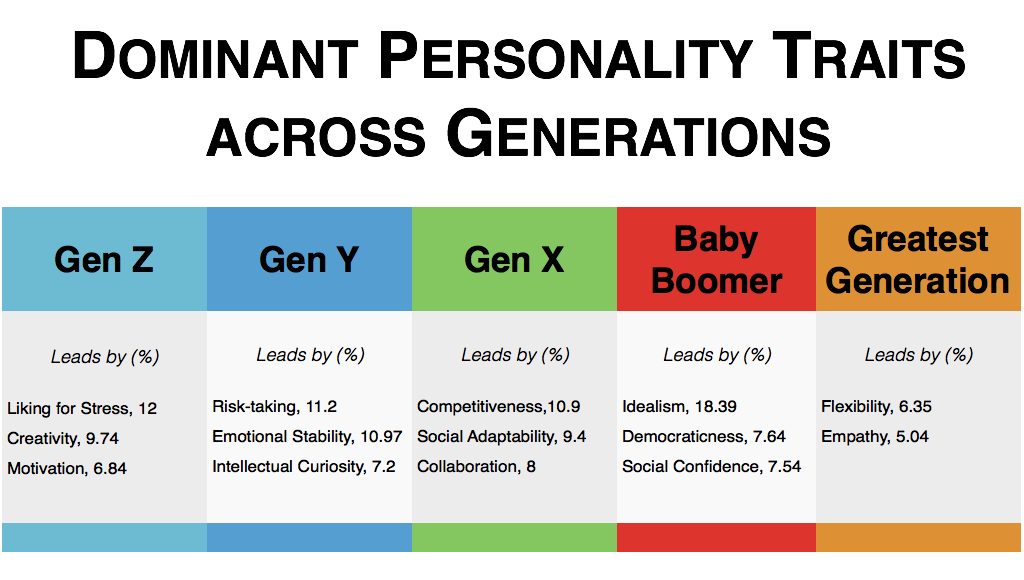 They also offer turnkey solutions on the fly and show that they are ready to do more than is required.
They also offer turnkey solutions on the fly and show that they are ready to do more than is required.
Type I: Influential, yellow
Cheerful optimists and pleasant conversationalists are Type I people. Because of their habit of jumping from one subject to another in conversations, they are sometimes considered superficial. But they do it, for the most part, because they approach everything creatively. You can also say about them: convincing, pleasant, trusting.
Pluses:
- high communication skills;
- thinking outside the box;
- often become the soul of the team.
Cons:
- lack of punctuality;
- impulsiveness;
- inability to work with papers and numbers.
How to recognize at the first interview. Influencers always try to be benevolent. It would seem that almost all candidates do this, but it is these people who maintain a positive attitude under any circumstances, even for a stressful interview.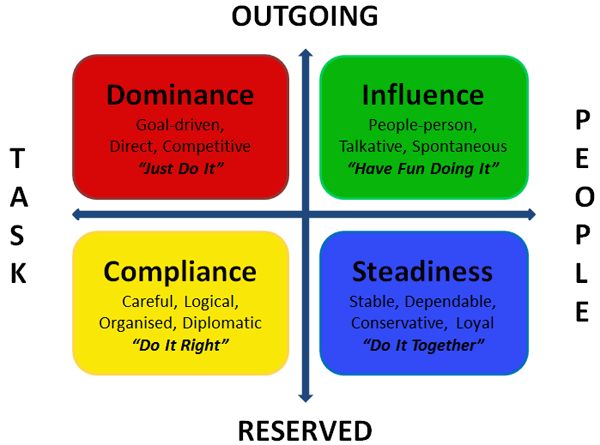 They also always stand out with their appearance, bright accessories or gesticulate a lot, which distinguishes them from other candidates.
They also always stand out with their appearance, bright accessories or gesticulate a lot, which distinguishes them from other candidates.
Type S: Standing, green
Type S people have calm and gentle personalities. They have a high need for stability and reliability. These are those who definitely do not like change, especially when it is difficult to experience moments when changes occur abruptly. "Permanent" are attentive to people's emotions, empathize and have a sense of tact. Type S are stable and patient individuals, they are suitable for measured work in the long run.
Pros:
- reliability;
- are simply made for routine work;
- they always have perfect order both in business and in the workplace.
Minuses:
- touchiness;
- do not know how to say "no";
- secretive, do not like to discuss problems.
How to recognize at the first interview. Usually such candidates do not have an abundance of previous jobs in the resume.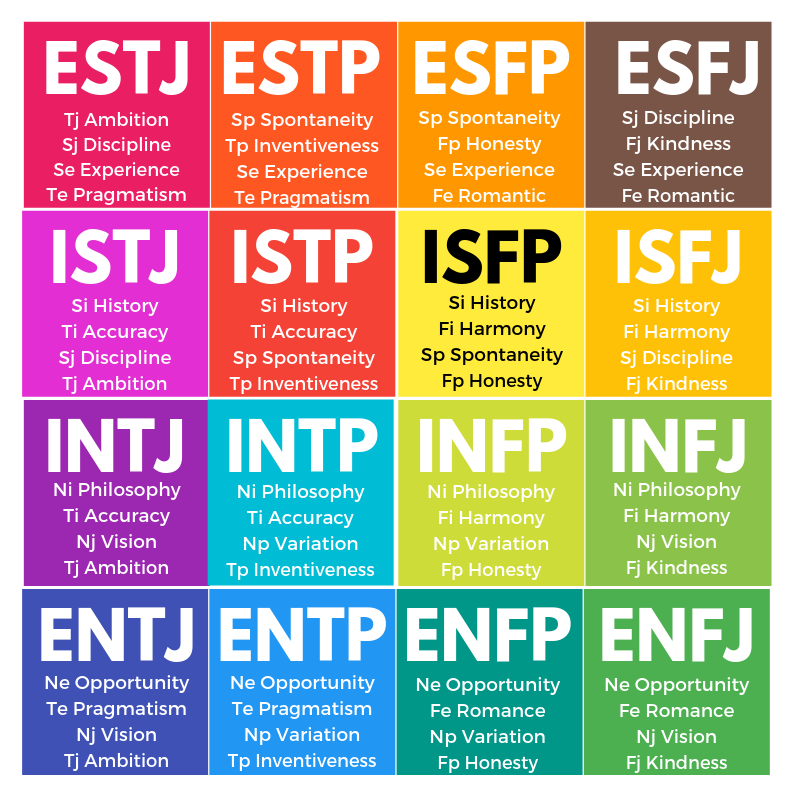 They work long enough in the same organization, and if they decide to change jobs, then something really “terrible” has happened. Such employees will become a reliable rear for the company, if you provide them with comfortable conditions.
They work long enough in the same organization, and if they decide to change jobs, then something really “terrible” has happened. Such employees will become a reliable rear for the company, if you provide them with comfortable conditions.
Type C: "Appropriate", blue
These people's "best friends" are charts and instructions. They like to follow the rules and treat everything with caution. Sometimes they give the impression of cold and closed personalities, but at the same time remain diplomatic and tactful.
Pluses:
- organization;
- know how to detail and analyze;
- accuracy.
Minuses:
- intolerance to other people's mistakes, self-criticism;
- compromise poorly;
- in a stressful situation often "withdraw into themselves."
How to recognize at the first interview. "Relevant" behave with restraint. The first questions at the interview from such candidates will most likely be about numbers: the amount and dates of wages, the number of days of vacation and sick leave.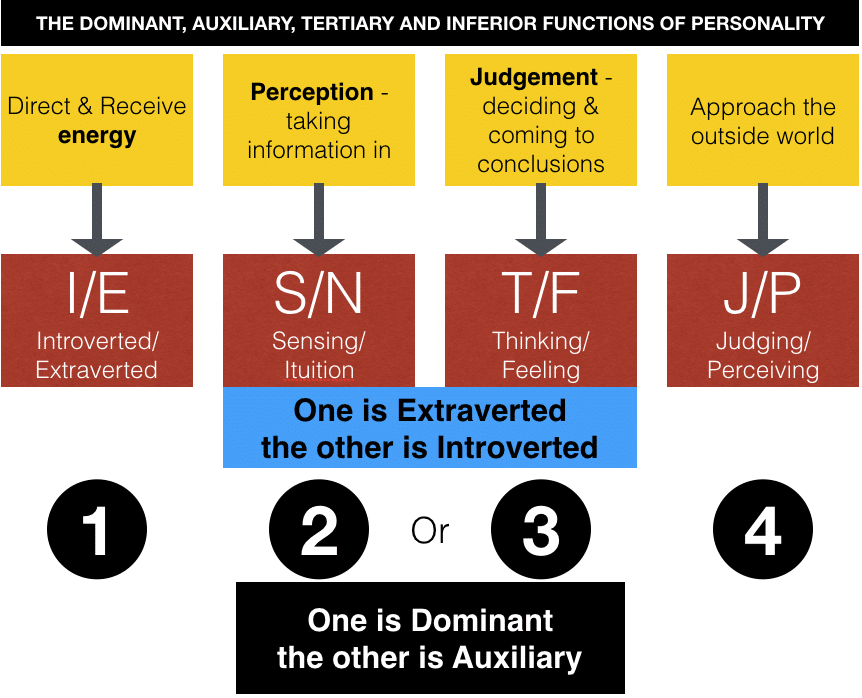 They analyze everything you say and always ask clarifying questions.
They analyze everything you say and always ask clarifying questions.
How to apply DISC to employees?
DISC in action becomes clearer when the HR professional visualizes it as a circle. To do this, it is divided into 4 parts, in the upper half there are extroverts (expressive personalities), on the bottom - introverts (more restrained).
Sharp movements, quick speech, and lightning-fast decision-making are all exhibited by extroverts. Introverts often speak more slowly and in a softer tone. They take more time to determine their point of view.
Hemispheres give an understanding of what the employee is really focused on: performing tasks or interacting with people. The left one shows task-oriented personalities. They tend to think logically, think about the result. The right half displays those who are people-oriented. They prefer to focus on experiences, feelings, relationships and social interaction.
It may happen that a person has a mixed dominant type of behavior.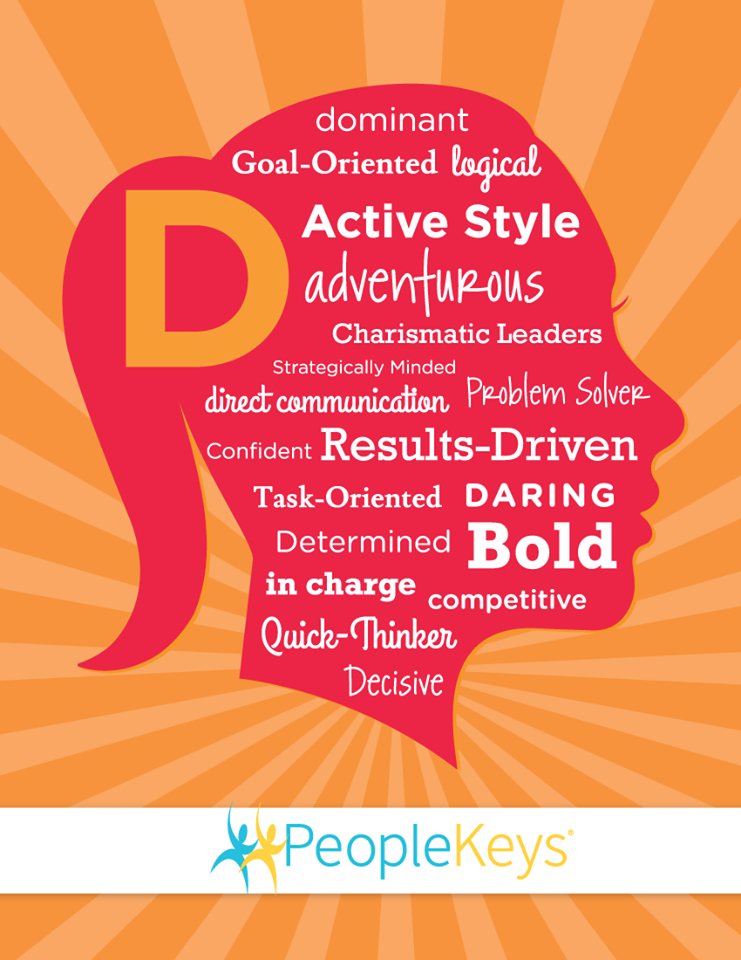 This means that the qualities of the two types can manifest themselves equally. For example:
This means that the qualities of the two types can manifest themselves equally. For example:
Type DI: "Inspirer", red-yellow
They know how to influence people, are charismatic, due to which they occupy a leading position in the team. They always achieve the desired results in negotiations, they know how to prove their point of view. They are comfortable in a competitive environment. On the other hand, they often put pressure on people and manipulate other people's opinions, and also demonstrate an aggressive type of behavior.
Type IS: "Communicator", yellow-green
They are easy to get along with. They are warm personalities with a flexible behavior model. Yellow-greens, like no other, know how to empathize and forgive. This is both a positive and a negative feature, because sometimes others actively use it.
Type SC: "Coordinator", green-blue
"Coordinators" perfectly combine the ability to analyze and work with people. They are reliable and comfortable in a stable environment.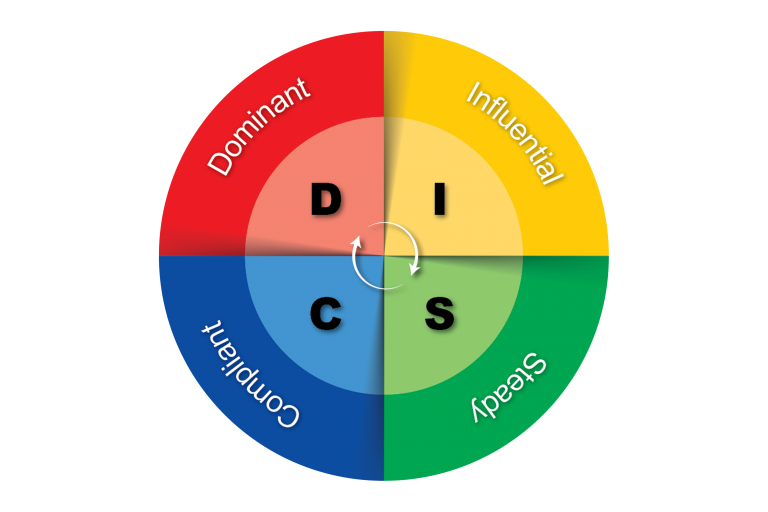 Of the minuses - the lack of ambition and the tendency to close from everyone in stressful situations.
Of the minuses - the lack of ambition and the tendency to close from everyone in stressful situations.
Type DC: "Performer", red-blue
Representatives of this type, on the contrary, get bored in comfortable conditions. They love instability and change. They try to perfect all their tasks, but they can bring other people almost to madness. The fact is that the red-blue will be among the first to support innovation and at the same time criticize other people's ideas to the nines.
How to understand HR who is who in the team, if the DISC method was not used at the interview stage? The easiest way is to ask the employee to take a short test. Note that the HR specialist should immediately explain to the employee: this is not the case when you need to answer right or wrong, or
try to show the "best result". Here, maximum honesty and individuality are important.
The questionnaire usually consists of a series of statements to which the person must select an answer on a rating scale: "I strongly agree", "I agree", "I am neutral", "I disagree", "I strongly disagree".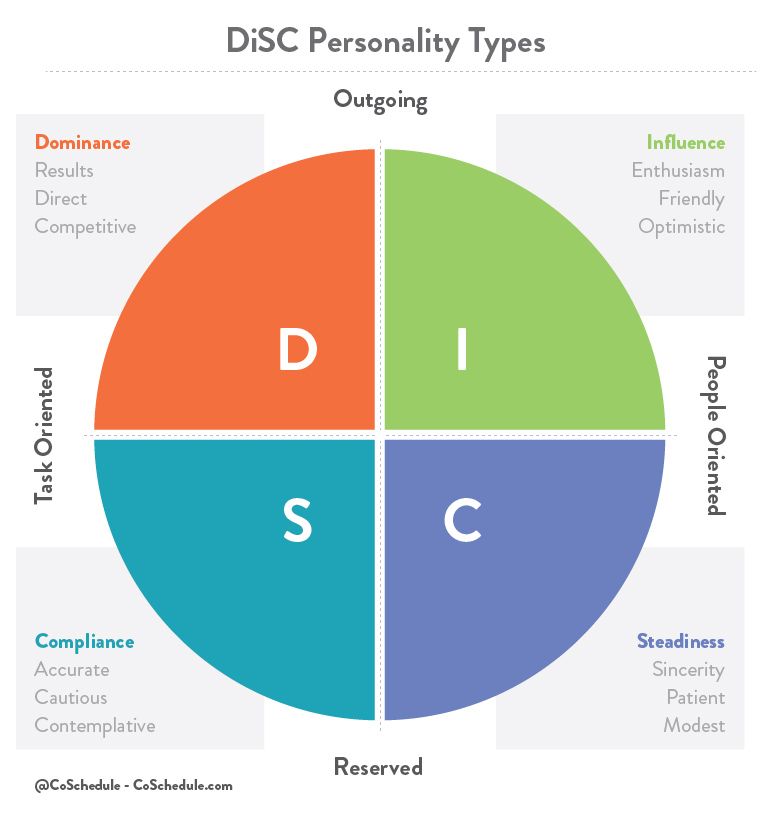 Most DISC personality tests are now done online, for example here. After the employee has given answers, determine what type he belongs to and decide what tasks he is best suited for, taking into account his pros and cons. If he answered so that he scored approximately the same number of points and belongs to two types, evaluate him according to the description of subtypes.
Most DISC personality tests are now done online, for example here. After the employee has given answers, determine what type he belongs to and decide what tasks he is best suited for, taking into account his pros and cons. If he answered so that he scored approximately the same number of points and belongs to two types, evaluate him according to the description of subtypes.
It is important to remember that no type can be defined as better or worse, they are just different. All four DISC personality types, and their subtypes, have their own strengths and weaknesses, as well as positives and negatives. The DISC practice is designed to help HR understand how an employee tends to approach day-to-day work, what qualities they can show, and how well they work with other people.
instructions for use - Career on vc.ru
Almost every team has at least one employee with a dominant personality type. They are motivated by winning, competing and achieving results. They are bossy and confident, but can also be stubborn, aggressive, and overly direct.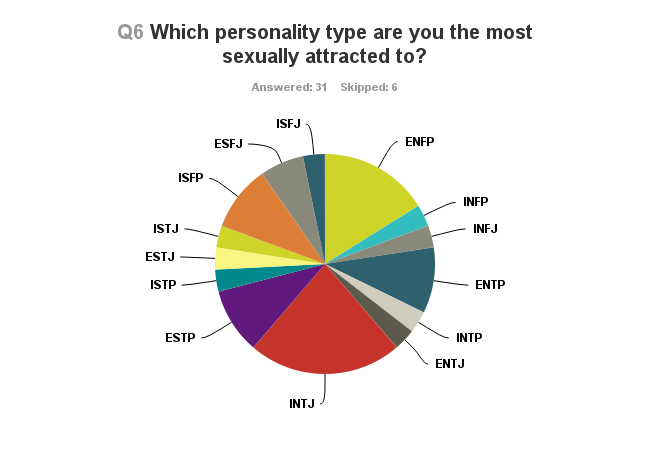
824 views
Working with such people is not easy, especially if you yourself are a reserved, sensitive and not at all pushy person. But if you want to succeed in your career, it is important to learn how to work with all colleagues, including those with a dominant personality type.
Here are 6 ways to effectively build relationships with them.
1. Focus on the what, not the how.
The dominant type is task oriented. He cares about results, not processes. When talking to him, focus on concrete, tangible facts. It's better to make direct statements than to have a brainstorming session. Talk about how your proposal affects the end result and expected results.
2. Skip polite phrases.
Dominant personality types work in A.S.A.P mode. and value efficiency. These are the type of colleagues with whom it is better to omit pleasantries and get straight to the point. For example, omit phrases like "How are you?" or "I hope you're doing well" at the beginning of emails.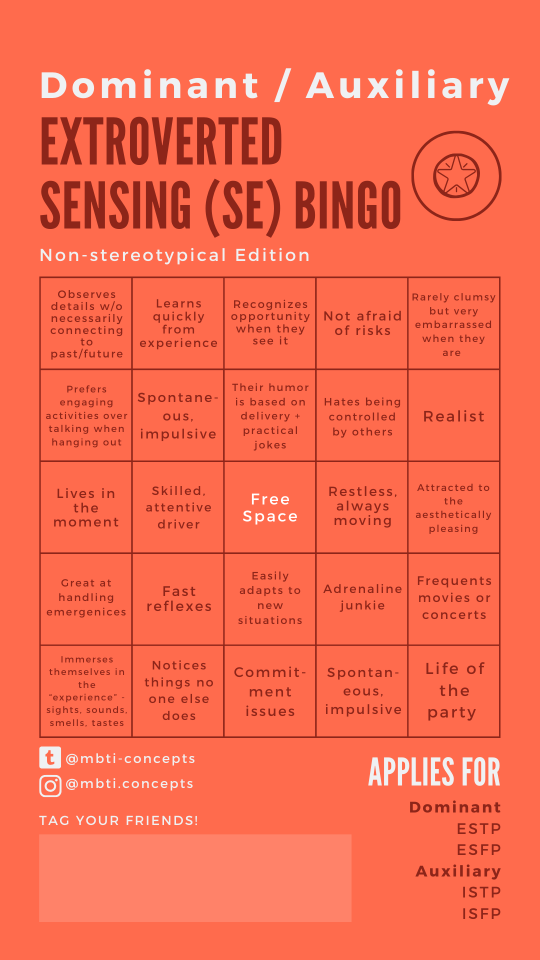 Similarly, in a meeting, jump straight to the agenda.
Similarly, in a meeting, jump straight to the agenda.
Do not waste the dominant type's time retelling events, repeating details, or giving your opinion. Start with your key message and focus on the essentials.
3. Give them independence.
To influence an employee with a dominant personality type, you must understand that he is driven by the desire to achieve and control. The more space you give this person to solve problems and make decisions on their own, the more effectively they will work. Dominant personalities value autonomy, so don't be surprised if one-on-one encounters are brief or non-existent. Before delegating authority to an employee with a dominant personality type, make sure that the areas of authority are clearly defined and articulated. Give him bold, ambitious long-term goals so that he constantly strives for more.
4. Explain why they need to change something.
When giving these people feedback on their work, focus on how the behavior changes you are asking for will help them achieve their goals and achieve better results.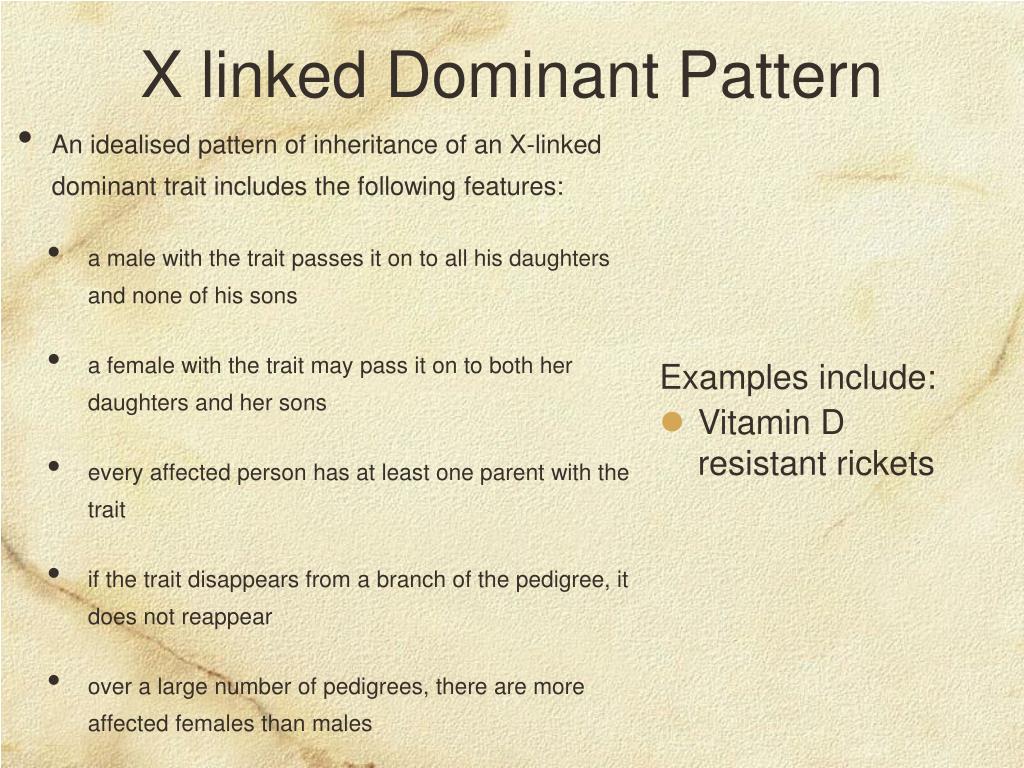 For example: “Your directness negatively affects your direct reports. If team members leave, it will mean that you will have fewer resources to carry out client sales, and therefore you may not achieve your goals.”
For example: “Your directness negatively affects your direct reports. If team members leave, it will mean that you will have fewer resources to carry out client sales, and therefore you may not achieve your goals.”
You can also use comparison as a way to constructively motivate employees with a dominant personality style. For example, highlight competitors that perform better to push them to develop.
5. Fill in the blanks.
Healthy, productive teams are made up of employees with different personality types.
While dominant types tend to innovate and progress, they can also ignore risks and act too quickly. If you tend to make decisions more carefully and deliberately, you can bring stability and rationality to the process. Similarly, you can be the one who breaks down ambitious plans into detail and directs the actual implementation.
6. Don't take their actions personally.
Employees with a dominant personality type may respond harshly.